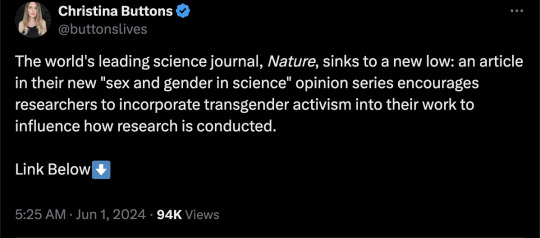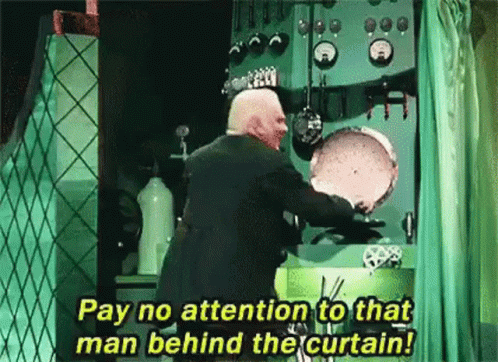#Nature Magazine
Explore tagged Tumblr posts
Text


By: Christina Buttons
Published: May 31, 2024
The prominent science journal Nature has launched a new opinion article series on sex and gender. One paper in this series explores research attempting to search for a biological basis for trans-identity, arguing that such research could “pathologize” and “harm” the trans community. The authors discourage “investigations into the underlying bases of transgender identity” and propose various steps for researchers to incorporate transgender activism into their work to influence research outcomes — signaling the end of Nature’s commitment to pursuing scientific truth over ideology.
The article starts by reviewing neuroscientific studies aimed at finding the cause of trans-identity in the brain, identifying 83 papers from 1991-2024. It highlights the transgender brain-sex hypothesis, which suggests that trans-identified people have brain regions resembling those of the opposite sex. However, it neglects to mention that this hypothesis falls apart because the studies did not control for confounding variables such as sexual orientation.
The article does acknowledge that “the results of these analyses have been inconsistent.” Yet, when the media covers these studies, the public is often informed by headlines such as “transgender people are born that way,” “science proves trans people aren’t making it up,” and “attacks on trans people are also attacks on science itself.” You can read a simplified explainer I wrote debunking the brain-sex studies here.
The authors move on to the more plausible “own-body perception” theory, which proposes that reduced structural and functional connectivity between certain brain networks is responsible for gender dysphoria. However, these studies do not show a causal link, only an association. Abnormalities in body perception networks in the brain are also associated with many other conditions, including body dysmorphic disorder, anorexia, body integrity identity disorder, schizophrenia, and autism.
After reviewing the neuroscientific studies, the article’s language shifts into typical activist rhetoric, claiming that research into transgender identity can be “harmful.” The authors argue that if brain scans or some other objective test could assess whether someone is experiencing gender dysphoria, it could be used to prevent people from accessing cross-sex hormones and surgeries if they are not deemed “eligible.”
"A second possibility is that neuroscientific findings related to transgender identity will fuel transphobic narratives," the authors write, citing a “feminist perspective” social science journal article on "Transprejudice."
For example, they state, "Some people argue that allowing transgender women to access infrastructure, such as public toilets or women’s prisons, threatens the safety of 'real women'." It is odd and audacious for a serious science publication to use "real women" in quotations. Moreover, their source for this claim is an article about Kathleen Stock, who does not argue that transgender women threaten the safety of biological women. In fact, she explicitly states the opposite: "I am definitely not saying that trans women are particularly dangerous – they are definitely not."
The authors also take a dig at sexologist Ray Blanchard, claiming that autogynephilia “hasn’t held up to scientific scrutiny,” citing a "feminist analysis" paper by a trans activist. Apparently, they haven't spent any time on trans Reddit, where they would encounter a vast discourse on "gender euphoria boners."


The authors end by setting “four actions” for researchers studying transgender people to prevent further “harm” from being done. They suggest researchers set up an advisory board and multidisciplinary teams consisting of transgender people to consult on their study designs and “prevent the outcomes of neuroscientific and other studies from being described and published in an overly deterministic and simplistic way.” They also dictate what should and should not be studied, suggesting researchers "prioritize research that is likely to improve people’s lives" rather than searching for the cause of trans-identity.
The final suggestion is to “rethink how ethical approval is obtained,” which relates to an example they provided of a 2021 UCLA study that was suspended after significant backlash from transgender activists. The study aimed to examine the brains of trans-identified individuals by showing them images of themselves wearing tight clothes, intending to trigger gender dysphoria. Although the study obtained ethical approval from their research institute and the transgender participants provided informed consent, it seems they weren't the right transgender people to ask permission from. Their suggestion implies that researchers must obtain approval for their studies from transgender activists.
The authors seem aware of the implications of their recommendations, as they conclude their article by admitting their approach would limit scientific inquiry:
“Our aim is not to halt scientific enquiry. But when it comes to transgender identity, knowledge cannot be pursued in isolation from the many societal factors that shape how that knowledge is received and acted on.”
This statement translates to prioritizing activism over truth-seeking when the findings might be inconvenient or misaligned with political narratives and activist goals. Such a stance compromises the integrity and credibility of science, reducing it to a tool for activism rather than a means of uncovering and understanding reality.
It is disheartening to watch one of the world’s most prestigious scientific journals compromise their credibility by continuing to prioritize ideology over truth.
Besides, the authors' concerns about discovering a biological cause for trans-identity are misplaced. While there are biological traits associated with being transgender, such as same-sex attraction and gender nonconformity, “transgender” itself does not appear to be an inherent condition one can be born with. The concept of "transgender," as understood in Western cultures, is a cultural construct that doesn't have a direct equivalent in many non-Western societies.
Research into a cause for gender dysphoria would be difficult because the transgender population has become so heterogeneous. Even if one were predisposed to a psychiatric condition like gender dysphoria, predispositions are not predeterminations of a transgender outcome. The notion of transgender identities being fixed at birth is further contested by the increasing number of detransitioners and extensive research on desistance among children, suggesting that such identities can often be temporary coping mechanisms for young people in distress.
==

We're just supposed to accept that hacking off body parts and giving life-altering drugs and hormones is a completely normal part of life. And that wondering where this is all coming from, what's underlying it is the problematic part.
At its core, the point of this ideology is to pathologize the completely normal and normalize the pathological.
Carl Sagan warned us about this:
"The truth may be puzzling. It may take some work to grapple with. It may be counterintuitive. It may contradict deeply held prejudices. It may not be consonant with what we desperately want to be true. But our preferences do not determine what's true." ― Carl Sagan
Reality is not obliged to conform to people's wishes or preferences, and we are not obligated to lie or consign ourselves to ignorance in order to placate those wishes and preferences. We don't allow "if you find out what's true, it'll hurt our feelings" - i.e. blasphemy - for the religious. Why are we allowing genderist fanatics to get away with it, when it's still just an accusation of blasphemy?
When people say, "you're not allowed to go looking over here, it's a moral failing to do so," the correct response is to go, "now I want to go look over there even more."
-
"Sex is real... But the belief that we have a moral duty to accept reality just because it is real is, I think, a fine definition of nihilism." ― Andrea Long Chu, gender cultist and lunatic
“The facts may tell you one thing. But, God is not limited by the facts. Choose faith in spite of the facts.” ― Joel Osteen, religious nutcase and lunatic
#Christina Buttons#Nature#Nature magazine#ideological corruption#science denial#blasphemy#corruption of science#scientific inquiry#gender ideology#gender identity ideology#queer theory#intersectional feminism#religion is a mental illness
14 notes
·
View notes
Photo

Nature Magazine - July 1929.
6 notes
·
View notes
Text
Covid-19 Tales (27)
One of the (many) mysteries of the Covid epidemic is why some people have so far escaped infection. The reason might be revealed in the results of a study carried out by Dr Marko Nikolić and his team at University College London in 2021 which have been recently published in Nature. 36 healthy adult volunteers who had no history of having Covid and were unvaccinated were given a low dose of the…

View On WordPress
0 notes
Link
A psyop to bind them all
#New World Order#Open Conspiracy#H.G. Wells#X Club#New Age#cybernetics#technocracy#neofeudalism#Nature Magazine#Fabian Society
0 notes
Text

blue hour in the alps
#blue hour#artists on tumblr#photographers on tumblr#mental health#mountains#art#naturecore#fairycore#nature aesthetic#nature#photography#photographer#cottagecore#switzerland#alpine trail#hiking trail#landscape#mountain landscape#mood#moody#mood magazine
3K notes
·
View notes
Text






scanned from ideals magazine
#scans#ideals#ideals magazine#70s#80s#vintage#vintage photography#photography#my scans#mine#nature photography
5K notes
·
View notes
Text

roel jacobs in zoom magazine american edition no. 15
1K notes
·
View notes
Text

Art by T. Edward Reyes 🩵🗡
#knight#knightcore#royalcore#medieval#art#magazine#pulp art#traditional art#fantasy#snow#japan#japanese art#crusade#armor#nature#sword#chivalry#loyalty#honor
2K notes
·
View notes
Text
Frisch described them in these words:
Very gradually we realized that the break-up of a uranium nucleus into two almost equal parts . . . had to be pictured in quite a different way. The picture is one . . . of the gradual deformation of the original uranium nucleus, its elongation, formation of a waist and finally separation of the two halves. The striking similarity of that picture with the process of fission by which bacteria multiply caused us to use the phrase 'nuclear fission'* in our first publication.
That publication was somewhat laboriously composed by long-distance telephone (Professor Meitner had gone to Stockholm, and I had returned to Copenhagen) and eventually appeared in Nature in February 1939. . . . The most striking feature of this novel form of nuclear reaction was the large energy liberated. . . . But the really important question was whether neutrons were liberated in the process, and that was a point which I, for one, completely missed.
* It was the American biologist James Arnold, also at that time working with Bohr in Copenhagen, who suggested this technical phrase from Arnold's own branch of science when Frisch described the phenomena to him.
"Brighter than a Thousand Suns: A Personal History of the Atomic Scientists" - Robert Jungk, translated by James Cleugh
#book quotes#brighter than a thousand suns#robert jungk#james cleugh#nonfiction#otto robert frisch#uranium#nucleus#nuclear fission#bacteria#phone call#lise meitner#stockholm#copenhagen#nature magazine#30s#1930s#american#biologist#james arnold#niels bohr#elongation#neutron
0 notes
Photo

Caroline Polachek for EVADE
2K notes
·
View notes
Text



Hoyeon Jung for Elle Korea (2021) Photographed: Tae-Kyun Kim
4K notes
·
View notes
Link
The stupid club
#Darwinism#Malthus#Huxley#The X Club#Nature Magazine#narrative control#groupthink#myopia#intellectual laziness#stagnation
0 notes
Text

#huge titts#big tiddy gf#big natural breasts#onlyfansbabe#big tiddy committee#huge tiddies#massive breasts#hot breast#lovely breasts#ebony queen#ebony women#ebony goddess#ebony babe#ebony big ass#black beauty#black woman#sexy ebony#black girl magic#finest black women#black women#blackmens digital magazine#black is beautiful#brownsugartitties
529 notes
·
View notes
Text

may mornings
#photographer#nature#autumn#fujifilm#season#canon#photography#nikon#landscape#leica#countryside#country#country cottage#film magazine#film photography#filmedit#film#film stills#lensbl#lensblr#lensbible#lenselust#lensculture#photograph#original content#original photographers#original photography blog#original post#original photography on tumblr#nature photography
1K notes
·
View notes
Text

Napping polar bear By: Dan Guravich From: Natural History Magazine 1989
562 notes
·
View notes
Text

A woman photographed laying on a literal ton(2.000 pounds) of weed while watching Johnny Carson by photographer Steve Cooper for High Times magazine, 1978.
#photography#art#contemporary art#high times#editorial#vintage#retro#70s#portrait#nature#landscape#cannabis#weed#magazine#aesthetic
5K notes
·
View notes